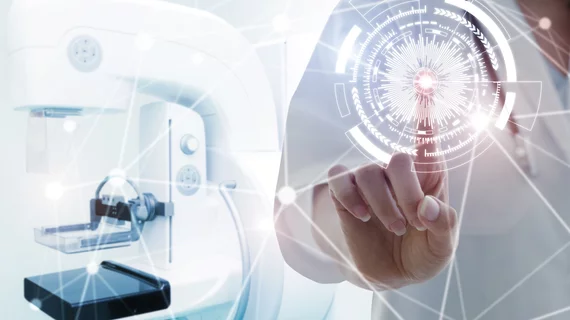Artificial intelligence outshines traditional risk model at predicting breast cancer
Scientists have demonstrated that artificial intelligence is more powerful than the standard forecasting method for predicting a patient’s chance of developing breast cancer.
Providers typically use a model, incorporating data such as a woman’s age, family history of the disease and whether she’s given birth or has dense breasts, to predict risk. Experts with Kaiser Permanente recently set out to see whether AI could perform the same task, using only a negative breast screening exam.
Their results, published Tuesday in Radiology [1], prove radiology providers can achieve better predictive results using even fewer data points.
“Clinical risk models depend on gathering information from different sources, which isn't always available or collected,” lead researcher Vignesh A. Arasu, MD, PhD, a practicing radiologist with KP Northern California, said in a June 6 announcement from RSNA. “Recent advances in AI deep learning provide us with the ability to extract hundreds to thousands of additional mammographic features.”
For the study, researchers gathered information from all women with negative screening exams imaged at Kaiser in 2016. They then retrospectively tracked their results through 2021, excluding those with prior breast cancer or genetic mutations, for a final sample of over 324,000 patients. Arasu et al. selected a random cohort of 13,600 women from that data set and combined it with 4,600 more from the eligibility pool who had been diagnosed with breast cancer since 2016.
The team then used the original index 2016 mammograms to test the performance of five AI algorithms, including two from academia and three from the commercial market. Measuring the results up against the Breast Cancer Surveillance Consortium (BCSC) risk model revealed a clear artificial intelligence advantage.
“All five AI algorithms performed better than the BCSC risk model for predicting breast cancer risk at 0 to 5 years," Arasu said in the announcement. “This strong predictive performance over the five-year period suggests AI is identifying both missed cancers and breast tissue features that help predict future cancer development. Something in mammograms allows us to track breast cancer risk. This is the 'black box' of AI.”
Zeroing in on individuals with the highest 10% risk, AI was able to predict 28% of cancers versus 21% for the risk model. AI’s performance appeared to diminish with longer time horizons past five years. However, most of the algorithms used for the study had not yet been trained on such longitudinal data, “suggesting a rich opportunity for further improvement,” the study noted.
“Moreover, AI provides a powerful way to stratify women for clinical considerations that necessitate shorter time horizons such as risk-based screening and supplemental imaging,” the study concluded. “The impact of AI models on clinical decisions requiring risk prediction beyond five years requires further study in cohorts with longer follow-up.”
Read more in the flagship journal of the Radiological Society of North America below.

